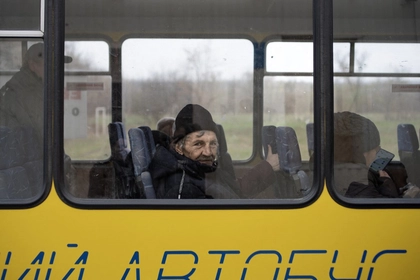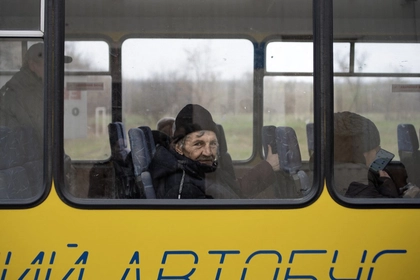NFL
Over 100K Ukrainians Return to Russian-Occupied Donbas as Economic Hardship Grows

Over 100K Ukrainians Return to Russian-Occupied Donbas as Economic Hardship Grows
IDPs who fled Russia’s invasion in 2022 are returning to their homes in the Donbas under Russian occupation because they cannot keep up with the cost of living in Ukrainian-controlled territory
130,000 Ukrainians have returned to their homes in the Russian-occupied Donbas territories in the last year due to the difficulties they faced living as internally displaced people since the full-scale invasion began in 2022.
The returnees all travel through Sheremetyevo Airport in Moscow to make the trip, Mariupol mayor advisor Petr Andriushchenko told Kyiv Post. Russia closed the last land border crossing between the Sumy region in Ukraine and the Kursk region in Russia when Kyiv launched its counteroffensive into the area over the summer.
Andrushchenko said he obtained the data from Russian officials overseeing the Sheremetyevo checkpoint, showing that the root cause for their return is finances.
“This wave last year began after Ukraine’s government canceled the social wage of Hr.2,000 ($48) for internally displaced Ukrainians. But the main reason is that they don’t have a place to live,” Andriushchenko said.
The average salary of a Ukrainian worker who fled Donbas in 2022 does not exceed the price of a monthly apartment rental in most of Ukraine, he added. This also keeps Ukraine’s most popular mortgage program, yeOselya, out of reach for IDPs, he added. Internally displaced Ukrainians only comprise 2% of the program’s 13,000 borrowers
“[The program] fits refugees from Kyiv, Bucha, Hostomel but people from Mariupol, Berdyansk, Volnovakha, Tokmak, and Melitopol cannot afford it.”
Cities like Kyiv have more jobs, which is why refugees tend to stay more often. Other regions do not share the same positive prospects, according to Andrushchenko. More people return from the west of Ukraine, but less from Dnipro.
In some regions, there are few refugees because the regions are “unfriendly for internally displaced persons” – meaning they could not find a job, the local prices were too high to get by, or the local society appeared “closed.”
Why Ukrainians Choose Sheremetyevo
After Russia closed the Kursk crossing along with its land entry points into Latvia, the airport became the only official way to enter the country for Ukrainians. The route involves traveling from Kyiv to Warsaw by bus, then to Minsk, and finally to Moscow by plane.
Upon arrival, Ukrainians must undergo “filtration.” Russian border officers interrogate them for fealty or affiliation to Ukraine. They check their documents and go through their phones to search for contacts, photos, messages, or any other record that could reveal a pro-Kyiv stance that would make them ineligible to return to Russian-occupied Donbas.
“We were kept on the floor in a little room for 27 hours,” Angelina, a young woman who recently returned home to occupied Donetsk to sell property, told Kyiv Post.
They handed me a questionnaire with absurd questions. For instance, ‘How do you feel about the Special Military Operation?’ – as the Russians call the war. If you express non-support for the war against Ukraine, you’ll face problems. If you say you support it, they might let you pass, but you’ll be at risk, as your profile could fall into the hands of Ukrainian special services – what then?”
“It’s a heavy moral burden,” she said.
Even after waiting days without food or much water, there is still no guarantee returnees will be allowed to enter Russian-controlled territory.
The Slippery Statistics
Andriushchenko’s team checked the data they received from Russian officials against initial from informants “who are based inside Mariupol,” he told Kyiv Post. They believe several thousand more people have tried to return home but have been pushed back at the border.
“Apart from the 120,000-130,000 people who entered occupied territory, around 200,000 were refused entry,” the Mariupol city council adviser said. “Another 50,000-70,000 were banned from entering Russia through the border crossing point at Minsk.”
The 130,000 estimate was given in August by lawmaker Maksym Tkachenko. Tkachenko is part of Ukrainian President Volodymyr Zelensky’s Servant of the People party and chairs a parliamentary group representing the rights of internally displaced Ukrainians. One local government representative from the east told Kyiv Post that the figure could be as high as 300,000, but Andriushchenko said he believed such figures to be “hype.”
The Russians have provided humbler statistics. Sheremetyevo border control representative Oksana Myshchenko told Russian TV channels that a total of 107,000 Ukrainians have arrived at Sheremetyevo Airport since October 2023 and just 83,000 were allowed to enter.
One conclusion is clear – at least 100,000 Ukrainians have made it back into Russian-occupied territory. This number is striking.
“Over 100,000 Ukrainians is quite a large number already,” Volodymyr Vakhitov, director of the Institute of Behavioral Studies at the American University in Kyiv, told Kyiv Post. “However, this number still represents a wide range of vague estimates voiced out by different officials from both sides of the border rather than hard evidence based on samples or surveys.”
Failing to Protect Internally Displaced Ukrainians
Lack of local infrastructure, accommodation, and jobs in host cities are also major problems for IDPs, Vakhitov said. With the scope of the problem millions large, cities and regions need to be supported by national policies, created at the national level.
Despite a successful decentralization reform in Ukraine, local governments in Ukraine still rely on administration in Kyiv to create solutions for IDPs, Vakhitov said. Local communities that host large numbers of people face scale-up challenges as they lack resources to quickly expand the local infrastructure, the AUK Institute for Behavioral Studies deputy director Nataliia Zaika added.
“The major issues they encounter include outdated residential norms, job market regulations and skills mismatch, and securing sufficient resources without additional assistance from the central government.”














